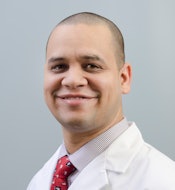
Racial, social, and economic disparities can negatively affect patient access to radiology -- and that's bad news not only for clinical outcomes, but also for a department's bottom line, according to research presented at the RSNA 2015 meeting.
One way to examine these disparities is to look at missed radiology appointments, which can result in delayed diagnosis, said presenter Dr. Efren Flores of Massachusetts General Hospital. The reasons patients may not appear for their appointments range from language barriers and cultural differences to practical issues such as transportation, child care, and an inability to miss work.
 Dr. Efren Flores from Massachusetts General Hospital.
Dr. Efren Flores from Massachusetts General Hospital."Missed appointments not only impact patient health, but they impact the practice financially," he told AuntMinnie.com. "We like to say that radiology cares, but we need to really put this care into practice, not just theorize about it."
The missed appointments are usually termed "no shows," Flores said. But this term isn't helpful, he told session attendees.
"The term 'no show' puts the responsibility solely on the patient," he said. "We prefer to use the term 'missed care opportunity' to describe scheduled but not attended healthcare encounters, because it includes the provider responsibility of making sure patients get the care they need."
Are you being served?
The impetus for the study was a Spanish-speaking patient Flores encountered who did not show up for two MR appointments because the reminder messages were in English, he said. The patient only attended the third appointment after a friend translated the reminder message.
"The situation with this patient made me wonder how many other encounters like it were happening," he told AuntMinnie.com.
Flores and colleagues searched almost 1 million exam codes between February 2014 and February 2015, identifying more than 550,000 outpatient imaging exams and a total of 42,773 missed appointments by 27,534 unique patients. The group analyzed the demographics of the patients who did not attend scheduled exams, including their age, gender, race/ethnicity, language, address, and education, to evaluate the association between these missed care opportunities and socioeconomic and demographic factors.
Missed care opportunities were the most common reason for not completing a radiology exam, at 41.5%, the researchers found. Overall, there were about 43,000, or 5%, missed radiology appointments during the study time frame.
| Missed radiology exams by procedure type | ||
| Modality | Number | Percentage |
| X-ray | 16,780 | 39% |
| Biopsy | 7,532 | 18% |
| Ultrasound | 6,561 | 15% |
| CT | 5,257 | 12% |
| MR | 2,136 | 5% |
| PET | 228 | 1% |
In terms of radiologic specialty, the most common missed appointments occurred in musculoskeletal, gastrointestinal/genitourinary, and breast imaging, Flores' group found.
Lower education levels, living out of state, having a primary language besides English, and being African-American or Hispanic all had a statistically significant association with missed appointments.
"These missed care opportunities affect minorities to a greater extent, and our results suggest opportunities for intervention to improve access," he told session attendees.
Bridging the gap
How can radiology practices help patients get the care they need? First of all, it's important to conduct a department self-assessment, Flores said.
"Every practice should analyze their client base," he said. "Is it diverse? Is the practice really engaging with its patients? We have a lot of information about our patients from their medical records, and we need to use it. We talk a lot about big data -- but it's more important to be smart about the data we have."
He offered a few suggestions for patient interventions:
- At the time the exam is scheduled, office staff can ask the patient if he or she needs specific support, such as help coordinating transportation.
- Telephone reminders for exams can be done in the patient's native language.
- Procedures can be scheduled with radiologists who have a similar background as the patient.
Another key suggestion is to offer appointment times outside of work hours, Flores said.
"We're in a service field, and it's not enough to offer patients appointments only between 9 a.m. and 5 p.m.," he said. "We need to be flexible in the same way other industries are flexible. You don't see grocery stores closing at 5 p.m."
In any case, it's clear that socioeconomic disparities exist in radiology, Flores said. And radiologists need to step up to mitigate the negative effects.
"If I never came out of the reading room, I never would have had that encounter with the patient who had missed the two MR exams," he told AuntMinnie.com. "Every exam we read represents a patient, and we need to get out there and meet with them."




















